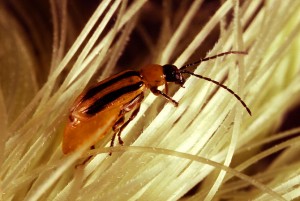
Face of the Enemy: Adult Western Corn Rootworm chewing on the silks of a corn ear. Picture from wikimedia, apparently in the public domain
This post discusses the paper Degenhardt, J et al. (2009) “Restoring a maize root signal that attracts insect-killing nematodes to control a major pest”
The Western Corn Rootworm (which as you can see from the picture to the right are not actually worms) is estimated to cost farmers in the US alone one billion dollars a year in lost yield and pest control measures. The newly hatched larva begin feeding on root hairs and as they get bigger start attacking the main roots of a corn plant. The damage to the roots from the feeding itself is exacerbated by the open wounds becoming infected. The loss of roots both stresses the plant and reduces yield by decreasing the plant’s supply of nutrients and water, but also makes it much more vulnerable to lodging (getting blown down by a gust of wind). Oh, and did I mention the adults like to feed on the corn plant’s reproductive tissues, decreasing yield even further?
Rootworms are one of the pests controlled by plants genetically engineered to express BT a protein taken from organic agriculture. Without it, the 1 billion dollar price tag for rootworm damage and control would be even higher. But this isn’t an article about bt, it’s an article about how some corn already knows how to call for help when rootworms attack.
Rootworm larva may feast on the roots of maize, but they are in turn eaten by some species of nematodes.* And it turns out some kinds of corn know how to attract nematodes, and when they’re under attack by rootworms they do just that. The nematodes get a delicious meal of rootworms and the corn plant gets to keep more of its roots intact.
How do corn plants attract their, unintentional, nematode defenders? (more…)